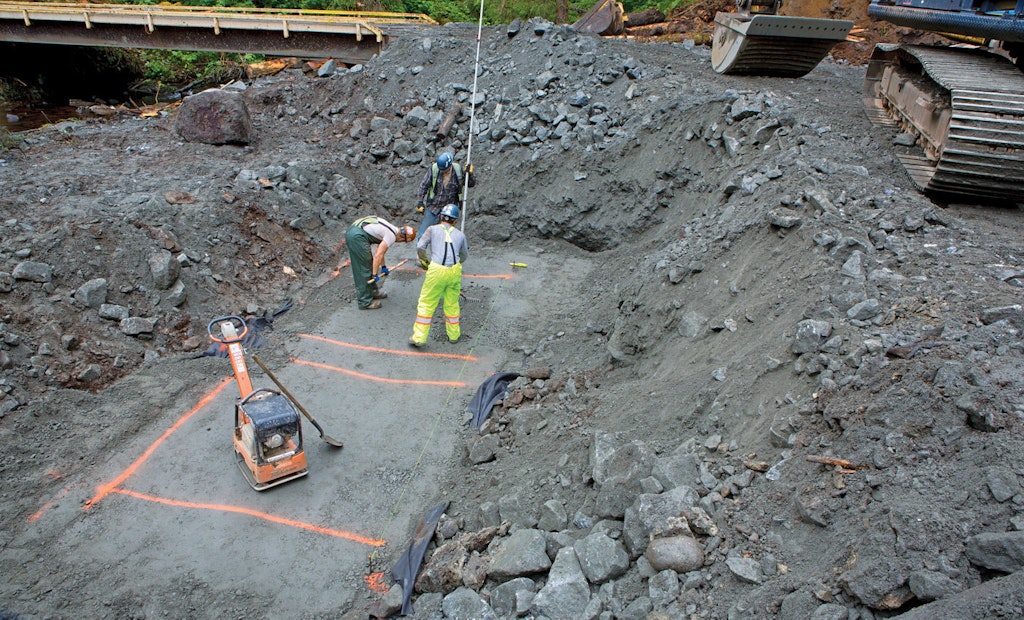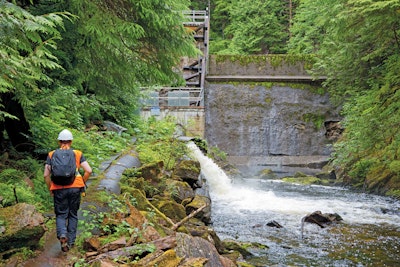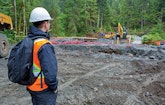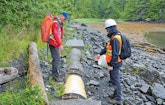
Interested in Rehab/Relining?
Get Rehab/Relining articles, news and videos right in your inbox! Sign up now.
Rehab/Relining + Get AlertsThe city of Prince Rupert, on the northwest coast of British Columbia, has every natural advantage needed to become the next great port city on the Pacific Ocean. Rebuilding city infrastructure, including the replacement of a 100-year-old water transmission main and dam located in an isolated forest preserve, is an essential part of that transformation.
On the leading edge of the 20th century, Charles Melville Hays, American president of the Grand Trunk Railway, selected Prince Rupert to be the western terminal of an expansive railroad system. Hays perished on the Titanic, but his dream of building a port city rivaling that of Vancouver remains alive. The city of Prince Rupert Operations Department is doing its part to make sure that happens.
“We call the project Hays 2.0,” says Director of Operations Richard Pucci, CET, AScT. “We want to realize Charles Hays’ vision and expand our port to become a major link to Asia across the Pacific Ocean and to Europe through the trade corridor emerging through the Northern Sea Route.”
An island city
The city was incorporated in 1910 on Kaien Island, according to a plan created by Boston landscape architects Brett & Hall. Featuring curvilinear streets and open spaces, the city has remained true to that vision.
Today, Prince Rupert’s Operations Department manages water, sewer and roads in this city of 13,000 residents.
“In the early 1900s, water was provided for the city using a wooden dam structure on Mount Hays, here on the island,” Pucci says. “But it was replaced in 1929 with a submarine line that pumped water under the harbor from Shawatlan Lake on the mainland. Today, our primary water source is gravity fed from Woodworth Lake through a submarine line to our reservoir.”
The 1929 line eventually flooded and was replaced by two lines in 1967 and 1987. The Woodworth Dam was built on Woodworth Lake around World War I. The lake is an elevated body of water that once helped provide electric power to the community.
Both lakes are located in a nature conservancy on the mainland that is provincially protected, in part, to maintain water quality.
The transmission main from Woodworth Dam, also once part of the hydroelectric system, was acquired by the city in the 1980s as a new water supply that would take advantage of the gravity feed from the lake.
The transmission pipe is 1.4 miles of 50-inch-diameter, rolled steel, bell-and-spigot pipe. The pipe runs almost entirely above ground in an area that’s so isolated crews must take boats or helicopters to the mainland to work there. In some locations, the pipe is strapped by cable to the mountainside.
Steam power
“The original construction was done by cable and rail car, with a steam engine placed at the top of the slope,” Pucci says. “After every fifth or sixth section they installed, they rolled one piece of pipe into the bush as a possible replacement. They knew how difficult it would be to get back after original construction.”
The builders’ plan was a good one. A landslide in 2008 took out a long section of pipe and required the installation of three of the reserve pipe sections left behind.
“We had to build a road to where the slide was, dragged the pipes out, heated them, shaped them and put them into service,” says Pucci. “We’re grateful that the line was down for maintenance at the time because if it had been fully charged it, would have interrupted supply and caused catastrophic damage to the natural habitat. It would also have scoured part of that side slope, tainting our lower water source at Shawatlans.”
The original construction methods used lead and oakum joints. Although the pipe is in good shape for its age, Operations crews have attended to an increasing number of leaks.
“You can see the water supply location from city hall,” says Veronika Stewart, communications manager for the city of Prince Rupert. “But it takes a half day to get there by boat and truck to get to the dam. Inspecting the dam and pipe means walking its length or riding alongside it on an ATV.”
Wind and rain can make inspection even more arduous. City workers on that assignment always carry radios and travel in pairs.
The new pipe will connect to 3 miles of pipe built in 1995 to take the potable water to the shoreline. The submarine lines run about 600 feet in length. While the 1987 submarine pipe is still in good shape, the 1967 pipe is beginning to show signs of corrosion.
Three phases to renewal
“We’re currently working on a three-phase approach to renew our water supply infrastructure,” Pucci says. “First, we’ll replace the original transmission line, followed by the dam and finally the underwater transmission line that brings potable water across the harbor.”
The project has been a primary goal for Pucci and the utility since he assumed his role in 2015. It has been championed both by city council and Mayor Lee Brain. It’s also part of the city’s goal for sustainability and self-reliance by 2030 — the dam replacement could once again contribute hydroelectric power to the grid.
The city sought the support of residents by producing a video designed to demonstrate the state of the aging infrastructure, which few of them will ever see.
The replacement of the aging steel supply line and construction of a bridge and access road is a $6.9-million-dollar project funded by federal and provincial Building Canada Fund grants covering two-thirds of the costs. The city is covering the remainder through its Prince Rupert Legacy fund, a wholly owned subsidiary of the city of Prince Rupert, funded through a lease option with a liquefied natural gas proponent on industrial lands owned by the city. The budget includes a 15 percent contingency, simply because the project is so remote.
The construction contract was awarded to remote building specialist Kledo Construction of Fort St. John, which worked along the small right-of-way for the pipe that is reserved for the city.
Kledo Construction owner Brent Doyle arranged to use a nearby lumber yard as a staging area for aggregate, fusible 42-inch HDPE pipe, and fusing equipment brought in by barge. All told, the project required in excess of 100 barge loads of material.
Roadway is essential
Construction of a permanent gravel access road is essential to allow contractors access to rebuild the Woodworth Dam. The HDPE pipe will be located underneath the road.
During the length of the project, the city reverted to its backup water source: Shawatlan Lake.
The dam replacement project is budgeted at $8.6 million. It’s funded primarily by the federal and provincially managed Clean Water and Wastewater Fund with $1.5 million to be supplied by the Prince Rupert Legacy Fund.
“The new concrete dam will be approximately 8 feet taller than the original and will be built 100 feet downstream from the old dam,” Pucci says. “Once its complete, we’ll remove key parts of the old dam and let the upstream side of the new dam slowly recharge.”
The city is currently applying for $6 million in government funding to replace the 1967 submarine transmission line, a project that could be scheduled as early as 2018.
“A reliable potable water system is not only essential to the community, but will also be essential to the growth of Prince Rupert as the port city it was planned to be,” Pucci says. “We think Charles Hays would be proud.”
The art of self-reliance
Prince Rupert, British Columbia, is a modern city that remains somewhat isolated from larger cities, such as Vancouver. As a result, the city has become very self-reliant and even offers telephone and internet services through a locally-owned company. That’s also true of the Prince Rupert Operations Department, which wears many hats, including roads, water and sewers.
Much of the repair work for the utility is performed by in-house crews, including a pool of multitalented general laborers with a wide range of skills. For example, crews recently completed a repair on a large-diameter water main construction project inside the city without outside assistance.
Pipe is primarily made of ductile iron and cast iron with some concrete. Current pipe infrastructure ranges from a few inches to 36 inches in diameter. Most leaks are traceable to the oldest pipe and early construction methods. According to Richard Pucci, director of operations for the city of Prince Rupert, the usual culprits are settling, acidic soil and normal pipe wear. Again, the distance from supply lines helps determine the utility’s approach to repair.
“When we replace a length of pipe, we tend to do like for like, so ductile iron is replaced with more ductile,” Pucci says. “We keep a large stock of pipe on hand so that we won’t experience delays that would be caused by ordering unusual pipe specifications from suppliers far away.”
While the city has designed some pipe replacement projects, maintenance takes precedence. When a pipe leaks, crews tend to replace longer lengths of pipe, for example valve to valve, or manhole to manhole, slowly rejuvenating the system.
Typically, older muskeg and sand excavated from a trench is replaced with new gravel. Even here, the city has developed a system that stresses self-reliance.
“The city owns its own gravel quarry that we use to source our material,” Pucci says. “We then use the excavation in the gravel quarry as a landfill site and use the material we’ve taken out of the trench as cover for the landfill. Being on an island, we’re always looking for creative ways within the utility to sustain ourselves and give the public the best bang for its buck.”








